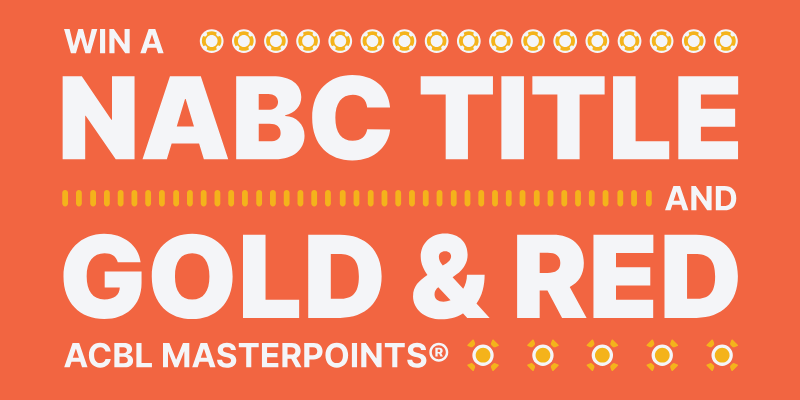


I hope the title doesn’t give away the theme of this column, which I’ve decided to start with two opening lead questions. I’ll give you two hands, with auctions, and ask you for your opening leads for both, then discuss.
First: NS Vul, you, West,
What do you lead?
Next: NS Vul, you, South
What do you lead?
These deals arose in two consecutive games in which I played, one live at the club and one in the marathon 3-Day NABC Robot 72-board tournament.
In my youth I read, maybe in teachings by Terence Reese, but I’ve not the resources to check, that usually a safe lead when nothing else presents itself is to under-lead the trump Ace. You are unlikely to trap your partner’s honor nor to give up an important tempo. Not that either of those is impossible, but we have addressed the thought that you have considered other leads and found them unattractive.
In both the deals above I advocated the lead, once to my partner who’d not heard that advice and one to myself, who made the lead. We’ll look at the complete deals in a moment.
I’ve searched the on-line literature about opening leads and can find nothing about this lead, only the usual beginner advice not to under-lead aces at suit contracts and the secondary or tertiary advice about when to lead trumps.
If you are going to lead trumps to cut down on dummy’s ruffing power, you ordinarily lead your Ace and another. Or, if you hold Axx, you consider leading a small one, planning to regain the lead, and then lead Ace and another. Here, we are trying merely not to destroy the defense but to get some extra information by looking at dummy to aid the defense. We could get that by laying down the trump Ace, but that might cost us a tempo. The trade-off is between retaining the lead if we lay down the Ace, for sure retaining tempo, and giving up that tempo to get more perspective on the deal and, perhaps, some partner cooperation.
Let’s look at the full first deal, next. East Deals, N-S Vulnerable
What’s the autopsy? A spade lead does no harm (provided partner is sufficiently alert not to cover the 10 from dummy). Heart and diamond leads each likely sacrifice a trick. A trump lead actually saves a cross-ruff trick.
Now, the second full deal. You remain South.
Let me remind you of the context: the second board of the 72-board NABC robot individual. I think I’m off to a great start. Look at that dummy in West. With four spades in dummy, we have at most one spade trick to go with our one heart trick. If partner can lead clubs, two club tricks will set the hand, but how to get partner in to lead clubs? Under-lead my spade Ace seems the only way. Declarer would then need to hold x Kxxxxx AJxx Kx. Is that plausible? I think a long time, which thinking time is free in an individual tournament, as there are no real time limits. Declarer might hold a singleton spade King, but partner needs to hold something for that intervention. I decide to under-lead the space Ace and …. Hooray. Partner wins the trick with the spade K and returns a … diamond. How can he do that? What motivates that return? Declarer can discard one club from dummy on his long diamond and make his contract. I, in my distracted state, fail to cover declarer’s club when he leads from his hand, so declarer loses no club tricks and makes five. Ouch. My partner engineered so that our top score for beating four hearts turned into a 15% score for holding a game not bid at most tables no overtricks and I engineered bad score into a flat zero.
Don’t get distracted here, Old Timer. The point of this deal is how well the opening under-lead of the trump Ace worked. 34 of 35 players in my seat defended hearts, 8 of them, four hearts. One defender, BBOer Rickhea, defended 3 hearts with an opening lead of a low spade, under-leading the Ace, to his partner’s King. Partner Robot shifted to a club, holding declarer to three and winning the top score of all 35 players. Well done Ricklea. The opportunity to under-lead the spade Ace persisted through several tricks—up through the point when South won his trump Ace. At several tables this did not occur until after two diamond and two heart tricks had been played, so South had some better idea of what was happening.
This is the sort of deal where the writer can turn the defender into an expert [lucky stab?], but the partner has to cooperate to create a dramatic headline. Nuts.
Don’t you be distracted by my histrionics. Think about the wisdom of the under-lead of the trump Ace.




On Example Bd#2 is it really underleading the SA when your Partner actually bids the suit. Me thinks not. It's a required lead. if Partner did not make the 3S bid there is another defense that actually defeats the contract as well; and that's leading the D9.
Way too complicated for me! As we say: KIS: Keep It Simple!
rather hard to follow